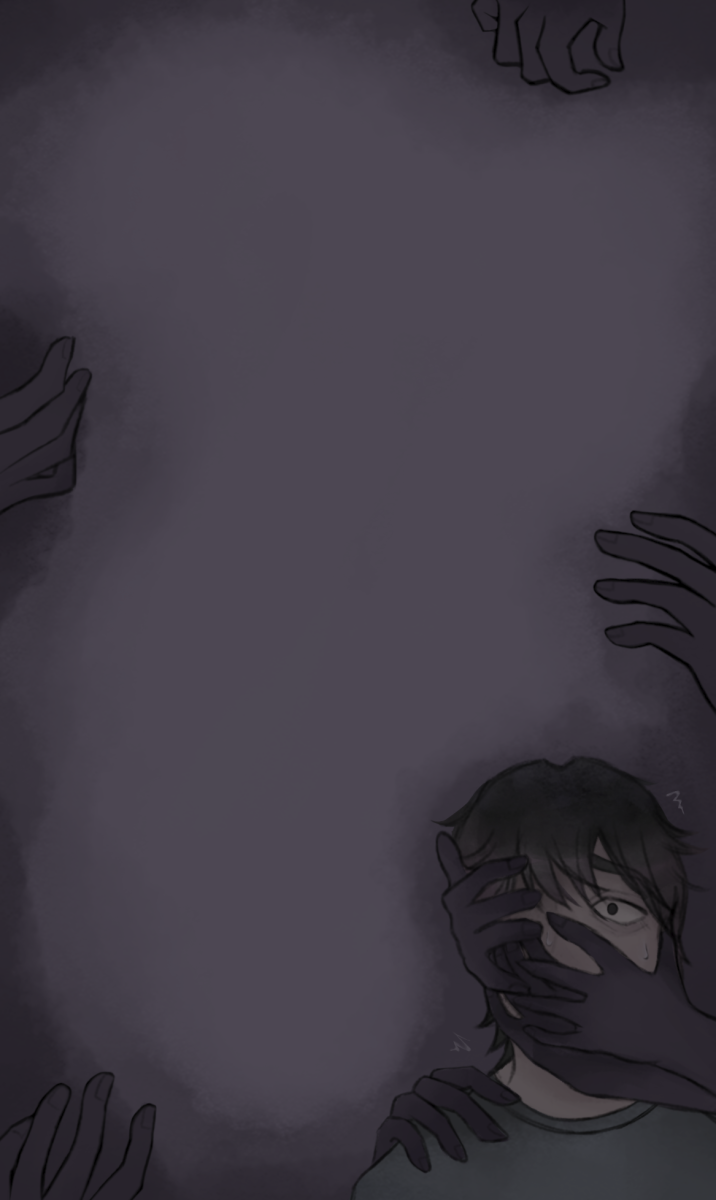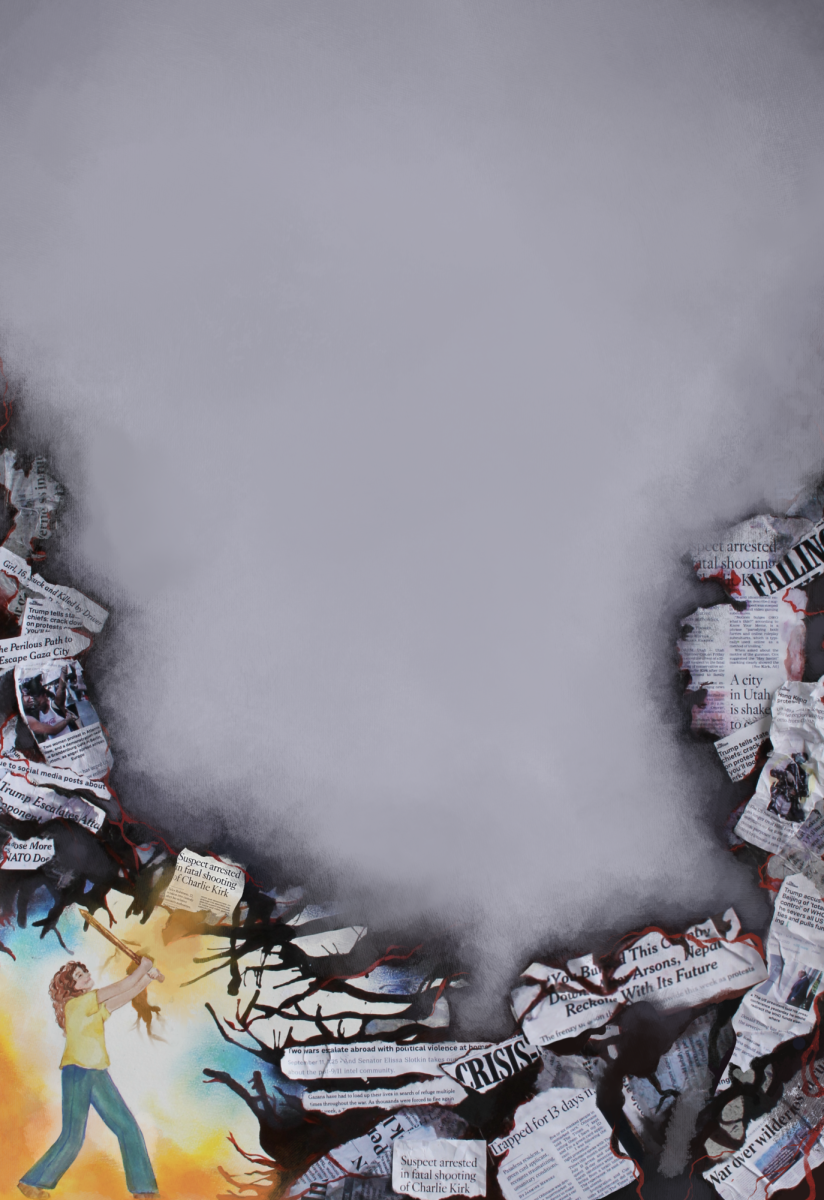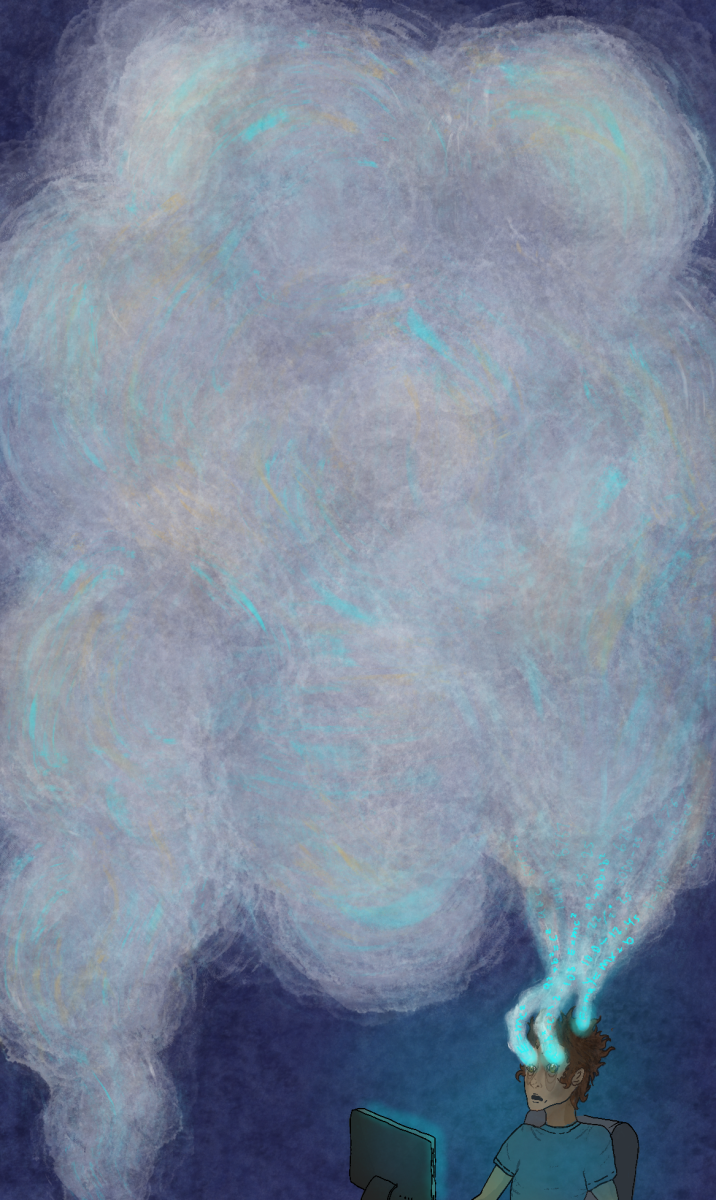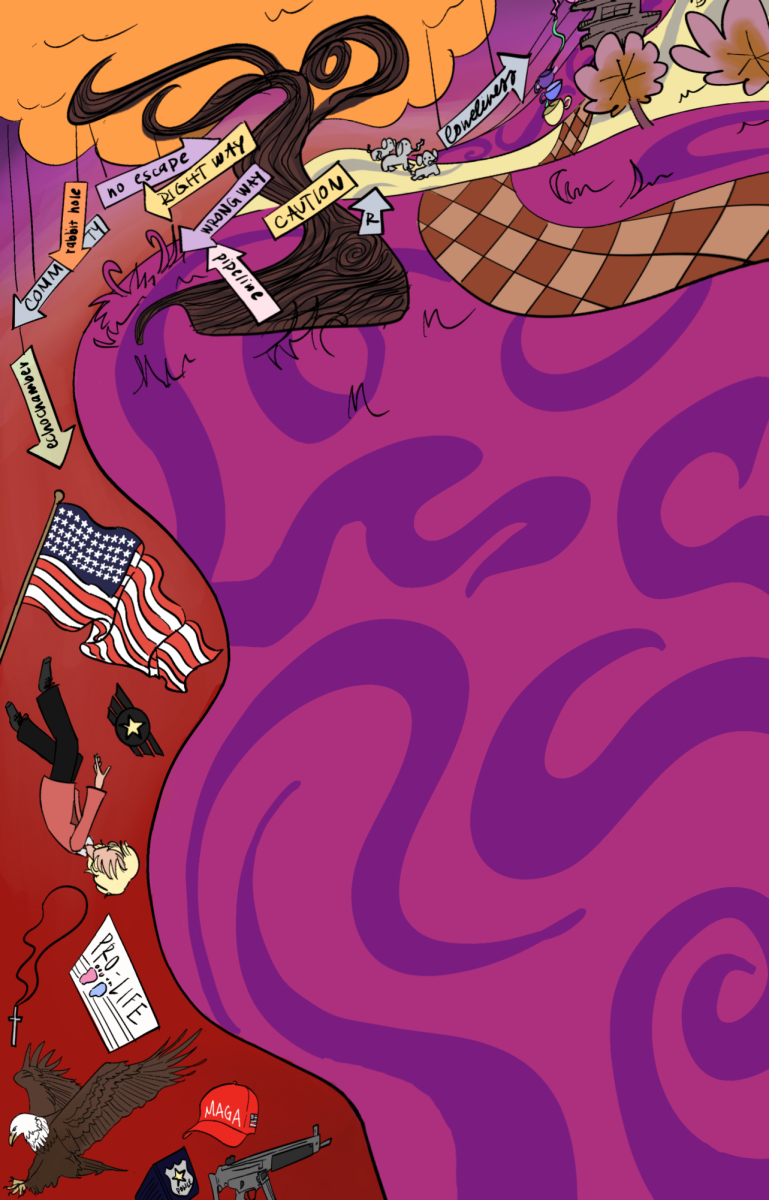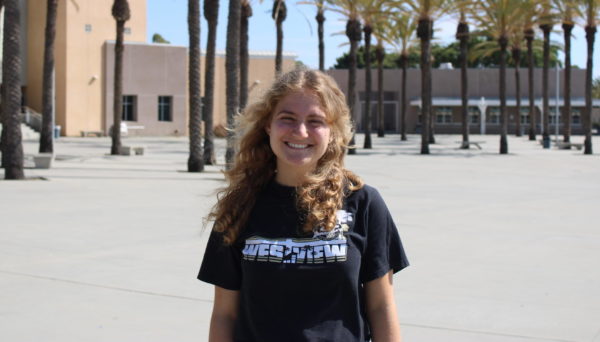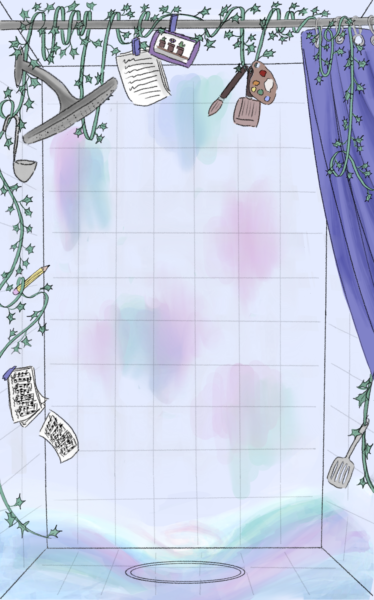
The Shower Effect
On a gloomy day in May, Gray Clink (12) was walking his dog in his canyon when an idea spontaneously struck for an AP Photography project.
“I took a picture of my bedroom and then I went down to the canyon and took a bunch of pictures of plants, then Photoshopped them together so it looked like my room was overgrown,” Clink said.
Clink’s moment of inspiration may not have been completely coincidental.
The colloquial term “shower thoughts” often refers to random, creative thoughts that occur when people are taking a shower or completing some part of their mundane daily routine. A related phenomenon known as the “shower effect” has been a topic of recent research, although these moments of creative inspiration don’t necessarily have to strike in the shower—many activities, from taking a walk, to doing chores or cook-ing dinner can allow the right amount of mind-wandering to stimulate creativity.
Dr. Zachary C. Irving, an assistant professor of philosophy of cognitive science at the University of Virginia, conducted a study published in 2022 about the “shower effect”: when mind-wandering facilitates creative incubation.
In his study, more than 300 students were asked to come up with novel uses for ordinary objects like a brick or paper clip in 90 seconds—a task known as the unusual uses task, which is used to test creativity. The students then either watched a boring scene of two men hanging laundry, or a moderately engaging clip of a well-known deli scene from the film When Harry Met Sally, allowing time for their thoughts to wander in what is known as an incubation task. Then the students were tested with the unusual uses task again.
“What we were really interested in was not the overall effect of watching a boring video versus watching an engaging video, but rather whether mind-wandering was more beneficial in one condition than the other,” Irving said. “What we found is that mind-wandering seemed to help [creativity], but only in the engaging video.”
More generally, Irving said that the results support the hypothesis that creativity can be aided by taking a break from the act of brainstorming itself.
There is a notable history of creatives engaging in moderate activities to boost ideas; Anh Vo (12) said his piano teacher once told him to go for a walk if he ever wanted an idea because Beethoven once did the same. Vo allows his mind to wander any time he listens to music, which he said helps him with improvisation and composition on the piano.
“The other day, I was watching Barbie with my friends, and I was listening to the soundtrack and my mind wandered subconsciously to the chord progressions of the tracks,” Vo said. “I heard this song I really liked [“I’m Just Ken”], and when I went home I started playing it and messing around with it. I played the chord progression with my left hand, did the melody with my right hand, and improvised.”
These experiences may seem coincidental, but going on a walk or watching a film and coming back with fresh ideas is empirically supported, Irving said.
“One explanation for the effects [of moderately engaging activities on creativity] could be that because the activity isn’t too hard, your mind is free to wander and it can explore a broad range of ideas,” Irving said. “But at the same time, there’s stimulus in that activity. When your mind is wandering, there are external stimuli and internal memories that are being activated based on that task.”
Izi Rodriguez (12) has also experienced spontaneous insight during an activity unrelated to her art. Once, she was in the shower when she began to reminisce about the color blue and thought of writing a poem centered around it.
“I came up with an idea for a poem centered around the question, ‘how come the sky never cries when it is blue?’” Rodriguez said. “I liked the line because it has both a literal and metaphorical meaning. I also came up with the idea of creating a whole hypothetical garden in the poem where everything is warped and completely different from what people usually think of when they think about a garden.”
Sleep States
Creativity doesn’t just strike during the day. The period between alert wakefulness and sleeping, known as hypnagogia when falling asleep and hypnopompia when waking up, can be a Goldilocks period for creative thinking to emerge.
Rodriguez said she believes she has written some of her best poems based on random ideas that came to her when falling asleep.
“One time, I was about to fall asleep, and I was thinking of nursery rhymes, [but] twisting the words to mean something else,” Rodriguez said. “I incorporated the idea into one of my poems. It was about innocence in childhood and having to grow up at a young age.”
This creative hotspot when falling asleep can be seen in a 2021 study from the Paris Brain Institute in which 103 participants were tasked with solving a difficult mathematical problem that could be made easier by uncovering an unprovided rule. After a period of time, some were allowed to fall into a hypnagogic state and then woken up, some fell all the way asleep, and some were kept awake. The researchers found that spending at least 15 seconds in N1 sleep (the hypnagogic state) tripled the chance of discovering the hidden rule and solving the math problem, but the same was not true for falling all the way asleep or staying awake.
Irving said that the nature of the brain’s detachment in the period when falling asleep or waking up contributes to this phenomenon.
“One explanation for it is you have less constraints in this sort of hypnagogic or hypnopompic state,” Irving said. “These thoughts belong to a similar family of [spontaneous] thought processes [as mind wandering]. They can all serve a similar function, allowing you to explore a broad range of ideas which is helpful for generating creative ideas.”
For Rodriguez, this spontaneous thinking is fruitful in serene circumstances, such as at night in her bed-room.
“Usually [to write], I need to be in a quiet area or sometimes I have to turn all the lights off,” she said, “I feel like [nighttime] sets the mood for me. I get the most creative ideas at night when I’m kind of tired, the day is catching up with me, and I’m done being completely focused.”
Gianni Ly (12), who cooks and writes for fun, said he’s had similar experiences with bursts of creativity at night, specifically when he’s less focused on tasks compared to daytime.
“[To be creative] I have to be tired,” Ly said. “Every time I try to start something creative after I shower and get ready [in the morning], it doesn’t come to me because I’m so easily distracted by everything. If I’m almost asleep, I can focus on one thing. I can pinpoint my mind on one topic.”
Positivity’s Role
The state of being creative has to do with mood as well as alertness. Vo said his most productive musical improvisation sessions occur when his emotions are positive or his energy is high.
“When I’m really carefree, and I’m content, I can hop on my piano and start improvising with a lot of ideas coming to mind,” Vo said. “Then there’s the other end of the spectrum, when I have a lot of work, and I go on the piano instead of doing my work [to decompress]. [Otherwise,] when I’m just in [an average mood], there are no ideas running through my head.”
In a 2021 study by Dr. Caitlin Mills at the University of New Hampshire, 79 undergraduate students received text messages at random points throughout their day inquiring about their state of mind. Analysis of the data found that there is a correlation between a positive mood and freely-wandering thought, while task-focused thoughts correlated with a more neutral mood, and obsessive-distracted thoughts with a negative one.
“There are different stages of creativity that contribute to coming up with original and useful ideas,” Irving said. “For creative people, you have stages where you’re generating a bunch of ideas, but you have other stages where you’re fixated on ideas, and you’re obsessing about them. If you’re in a positive mood, the mood might be causing you to engage in mind-wandering, which can aid creativity. But, [when in a negative mood], you’re exploiting ideas, focusing on them and trying to figure them out, which is important for creativity too.”
Ly said he finds inspiration for creating culinary experiences when feeling joy. One positive emotion struck during a house party, which provided inspiration for his rum-infused gougeres.
“If I experience an emotion or something that I want to convey through my food, I get a moment of clarity where I want to be able to have other people feel this,” he said. “[At the house party] I felt sort of warm but disquieted. The wash of inspiration that came with that just struck me at the moment, so I wrote some basic thoughts in my notes app which I keep for both literature and food.”
Ly said that it is important to him to be able to convey his emotions through food and share his creative visions with other people.
“The emotion of a dish comes from the way the flavors interact on your tongue,” he said. “In this case, the fruitiness of the liquor and the sharpness of the cheese [convey that experience].”
Harnessing Creativity
In order to harness creativity in one’s own life, Irving recommends taking breaks from the things that demand full attention—notably, technological distractions.
“One of the features of digital distractions [like social media] is this form of attention where you’re stuck fixating on something,” Irving said. “If you’re fixated on something, your mind can’t just wander. One of the things that can be important if you really want to cultivate spontaneity is cultivating time where you’re away from your phone and not just replacing that with working.”
There is neurological support that higher uses of technology may reduce individuals’ capacity for creativity. In a study published in 2022, researchers at the Shaanxi Normal University in China using neuroimaging found that having a smartphone addiction reduced the activity of subjects’ pre-frontal cortex and temporal areas when asked to think creatively compared to individuals without smart-phone addictions. The reasoning still requires further research, but previous research suggests that the overstimulation technology provides our brains may play a role.
There are innumerable things Irving suggests as replacements for screen time: take a walk outdoors, take a shower, wash some dishes, knit, craft, go for a run. The important thing, he said, is having time when you don’t need to do anything.
“These moderately engaging activities can cultivate a beneficial mode of spontaneity,” Irving said.
Although thoughts that come in the shower can be slippery, typing them on a phone directly after can preserve them. Similarly, by keeping a notepad by a bedside, thoughts can be written down immediately when they come during a hypnagogic state.
Zoey Lestyk (12) said that her art gets better when she allows time for spontaneous thinking.
“When you’re trying to force something, it often can’t work,” Lestyk said. “A lot of times when I’m just spacing out or having fun, doing something unrelated, that’s when I have some of the best ideas.”


